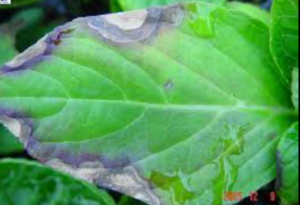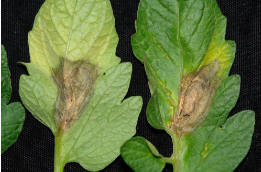Hello everyone, In this article we will know about Botrytis Disease and its important factor like introduction, identification cause of botrytis, precautions and its treatment.
Introduction of Botrytis Disease
Botrytis cinerea is a type of fungus known for causing “gray mold” in plants. It affects a wide range of plants, including fruits, vegetables, and ornamental plants.

The fungus thrives in humid conditions and can lead to significant crop losses by causing decay and rotting. Botrytis cinerea is especially problematic in vineyards, where it can affect grapes, sometimes leading to a condition known as “noble rot” that can actually be beneficial for certain types of wine production.
Proper management strategies, such as improving air circulation and using fungicides, are essential to control and mitigate the impact of this pathogen. Botrytis cinerea, commonly known as gray mold, is a fungal pathogen affecting various plants
Identification of Botrytis Disease

- It causes water-soaked lesions on leaves, stems, and fruits.
- The lesions eventually turn grayish-brown and are covered with a fuzzy, gray mold.
- Botrytis thrives in cool, damp, and crowded environments.
- Under high humidity, the fungus produces grayish spores, which are visible on affected plant parts.
- It commonly affects flowers, fruits, and vegetables, especially in conditions of high moisture and poor air circulation.
Read more:
- Malathion Insecticide : Best Information and uses in 2024
- Verticillium Wilt Disease: Identification, Cause, Precautions, And Treatment
Causes of Botrytis Disease
- The fungus thrives in environments with high moisture and poor air circulation.
- It prefers cooler temperatures, typically between 15°C and 25°C (59°F to 77°F).
- Dense plantings or overcrowded conditions can trap moisture and reduce airflow, creating a favorable environment for the fungus. Wounds or injuries to plants from physical damage, pests, or mechanical stress can serve as entry points for the pathogen.
- Excessive watering can increase humidity levels and contribute to favorable conditions for Botrytis.
- Decaying plant debris can harbor the fungus and act as a source of inoculum for new infections.
precautions: - Ensure proper spacing between plants to reduce humidity and improve air flow.
- Avoid overhead watering and ensure soil is well-drained to prevent excess moisture, which encourages fungal growth.
- Remove dead or infected plant parts to reduce the spread of the fungus.
- Use plant varieties known for their resistance to Botrytis. Sterilize tools and equipment regularly to avoid spreading the fungus. High-humidity environments, manage humidity levels carefully.
- Use fungicides as a preventive measure or at the first sign of infection, following recommended guidelines.
Minimize plant damage, as wounds can provide entry points for the fungus. - Ensure good airflow around plants to reduce humidity, which favors fungal growth. Avoid overcrowding plants to reduce humidity and improve light penetration.
- Remove and destroy infected plant material and debris from the growing area.Water plants at the base rather than overhead to keep foliage dry.
Treatment of Botrytis Disease

- Apply fungicides that are effective against Botrytis, such as those containing active ingredients like cyprodinil, fenhexamid, or boscalid.
- Always follow the manufacturer’s instructions for application rates and timing.
- Use biological agents like Trichoderma spp. or Bacillus subtilis, which can outcompete or inhibit Botrytis.
- Choose plant varieties that are resistant to Botrytis, if available.
- Maintain optimal temperatures for plant growth and avoid conditions that promote fungal growth.
- Implementing a combination of these methods can effectively manage Botrytis and reduce its impact on your plants.
- Botrytis, often referred to as Botrytis cinerea, is a type of fungus that can cause a range of plant diseases, commonly known as “gray mold”.
- It affects many crops, including grapes, tomatoes, and strawberries, particularly in conditions of high humidity and poor air circulation.
Conclusion
Botrytis cinerea can lead to significant economic losses in agriculture by damaging crops and reducing yields. Its impact is particularly severe in fruits and vegetables, where it causes decay and spoilage.
Effective management of Botrytis involves a combination of cultural practices, such as improving air circulation, using resistant plant varieties, and applying appropriate fungicides. Integrated pest management (IPM) strategies are often employed to reduce the incidence and severity of the diseases.
Research into more resistant crop varieties, better fungicide options, and improved management practices continues to be crucial for mitigating the effects of Botrytis cinerea. Continued monitoring and adaptation of strategies are necessary to address evolving challenges posed by this pathogen.
1. How to identify botrytis?
Botrytis, often referred to as “Botrytis cinerea,” is a fungal disease caused by a type of fungus in the genus Botrytis. It affects a wide range of plants, including fruits, vegetables, and ornamentals. The fungus thrives in humid conditions and can lead to significant crop damage by causing rotting and decay.
2. Is botrytis is harmful to human?
Botrytis, specifically Botrytis cinerea, is a fungus that affects plants and crops, causing diseases like grey mould. While it is primarily a concern for agriculture and it can produce mycotoxins that might pose health risks if inhaled or ingested in significant amounts. In general, casual contact with plants affected by Botrytis isn’t a major health concern for most people, but it’s wise to avoid inhaling dust or spores from affected plants and to practice good hygiene.
3. Is botrytis a bacteria?
No, Botrytis is not a bacteria; it is a type of fungus. Specifically, Botrytis cinerea is a species of fungus known for causing grey mould disease in plants. It belongs to the group of fungi known as Ascomycetes.
4. Why is botrytis risk?
Botrytis cinerea is a risk because it causes grey mould, which can quickly damage and spread across various plants, leading to significant crop losses and economic.
5. What temperature kill botrytis?
Botrytis cinerea is sensitive to high temperatures. It is typically killed at temperatures above 40°C (104°F). Temperatures can be challenging in natural environments, so managing humidity and air circulation is also crucial for controlling its spread.
6. What fungicides kill botrytis?
Effective fungicides for Botrytis cinerea include boscalid, fludioxonil, cyprodinil, and pyrimethanil.
How to stop botrytis?
7. To stop Botrytis cinerea, improve air circulation, control humidity, remove infected plant material, use appropriate fungicides, and maintain good plant hygiene.
8. Is botrytis a virus?
No, Botrytis is not a virus. It is a type of fungus, specifically a genus called Botrytis. One of the most well-known species within this genus is Botrytis cinerea, which causes gray mold on a variety of plants. This fungus can be particularly damaging in wet and humid conditions.
